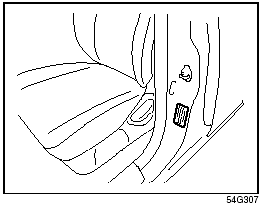 Suzuki Grand Vitara: Vehicle Loading
Suzuki Grand Vitara: Vehicle Loading

Vehicle Loading
Your vehicle was designed for specific weight capacities. The weight capacities of your vehicle are indicated by the Gross Vehicle Weight Rating (GVWR), the Gross Axle Weight Rating (GAWR, front and rear) and the Vehicle Capacity Weight. The GVWR and GAWR (front and rear) are listed on the Safety Certification Label which is located below the driver’s side door latch striker. The Vehicle Capacity Weight is listed on the Tire Information Label which is located below the Safety Certification Label. GVWR – Maximum permissible overall weight of the fully loaded vehicle (including all the occupants, accessories and cargo plus the trailer tongue weight if towing a trailer).
GAWR – (Front and Rear) Maximum permissible weight on an individual axle. Vehicle Capacity Weight – Maximum permissible load weight a vehicle can carry including the weight of all the occupants, accessories, cargo, plus trailer tongue weight (if towing a trailer). The weight of any accessories already installed on your vehicle at the time of purchase, or that you or the dealer install after purchase, must be subtracted from the Vehicle Capacity Weight to determine how much capacity remains available for occupants, cargo, and trailer tongue weight (if towing a trailer). Contact your dealer for further information. Actual weight of the loaded vehicle and actual loads at the front and rear axles can only be determined by weighing the vehicle using a vehicle scale. To measure the weight and load, try taking your vehicle to a highway weighing station, shipping company or inspection station for trucks, etc. Compare these weights to the GVWR and GAWR (front and rear) listed on the Safety Certification Label. If the gross vehicle weight or the load on either axle exceeds these ratings, you must remove enough weight to bring the load down to the rated capacity.
 WARNING: Never overload your
vehicle. The gross vehicle weight (sum of the weights of the loaded vehicle, driver
and passengers) must never exceed the Gross Vehicle Weight Rating (GVWR) listed
on the Safety Certification Label. In addition, never distribute a load so that
the weight on either the front or rear axle exceeds the Gross Axle Weight Rating
(GAWR) listed on the Safety Certification Label.
WARNING: Never overload your
vehicle. The gross vehicle weight (sum of the weights of the loaded vehicle, driver
and passengers) must never exceed the Gross Vehicle Weight Rating (GVWR) listed
on the Safety Certification Label. In addition, never distribute a load so that
the weight on either the front or rear axle exceeds the Gross Axle Weight Rating
(GAWR) listed on the Safety Certification Label.
 WARNING:
WARNING:
• Always distribute cargo evenly.
• To avoid personal injury or damage to your vehicle, always secure cargo to prevent
it from shifting if the vehicle moves suddenly.
• Place heavier objects on the floor and as far forward in the cargo area as possible.
Never pile cargo higher than the top of the seat backs.
 Trailer Towing
Trailer Towing
You can use your SUZUKI to tow a trailer, but you should always observe the requirements
and recommendations in this section. If you intend to tow a trailer, it is essential
to select a trailer an ...
See also:
Automatic connection
When the Bluetooth® function is active and the
most recently paired device is within range, it
is automatically connected. When the infotainment
system searches for the most recently
paired d ...
Luggage center box
The luggage center box is located under the floor in cargo area.You can place
a first aid kit, a reflector triangle, tools, etc. in the box for easy access.
1. Grasp the handle on the edge of t ...
Window Fogging
Interior fogging on the windshield can be quickly removed
by turning the mode selector to Defrost. The
Defrost/Floor mode can be used to maintain a clear
windshield and provide sufficient heatin ...

